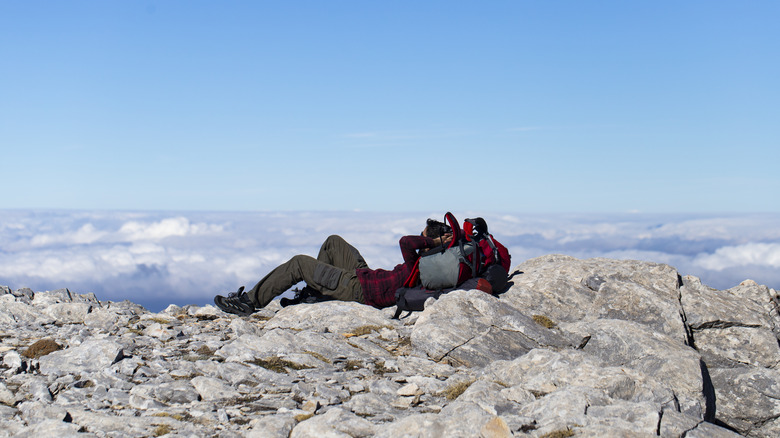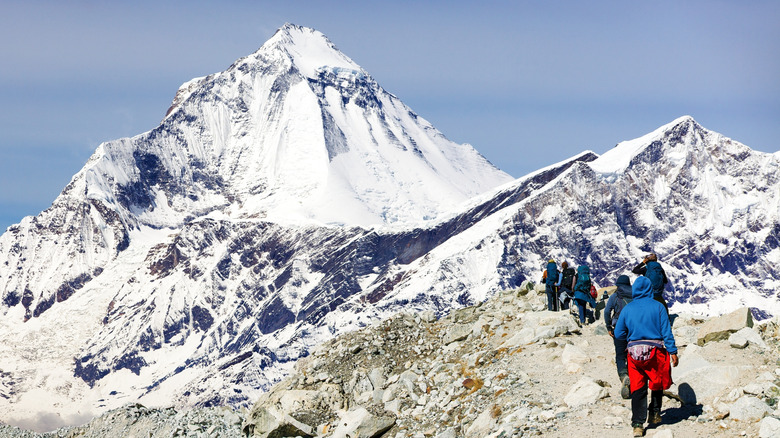Avoid Getting Altitude Sickness With These Handy Preparation Tips Before Traveling
So much of hiking is about preparation. You'll need the right gear, a decent understanding of trail maps, enough water and supplies, and some working knowledge of the wildlife in the area — you'll want to know what to do if you're out hiking and see a bear, for example. Some eventualities don't seem so obvious at the outset, like packing altitude sickness tablets, which help your body adjust more quickly to lower oxygen levels. But it's a good one to remember, because there's nothing worse than feeling nauseous and weary at 10,000 feet.
There are some things you can do to mitigate altitude sickness if you experience it on a hike, like descending to lower elevations. But prevention is often the best course of action, and the first stage of prevention is knowing what altitude sickness is and which symptoms to look out for. It kicks in when your body doesn't have time to adjust to the lower oxygen levels in the atmosphere at higher elevations. There are three distinct forms of altitude sickness: Acute mountain sickness (AMS), a mild, common form of the condition; high altitude pulmonary edema (HAPE), when the condition begins to affect your lungs, filling them with liquid, and; high altitude cerebral edema (HACE), the most severe form of the condition, causing your brain to swell.
Altitude sickness is rare below 8,000 feet — for reference, the highest point in the Appalachian Trail is only 6,643 feet — but most people who ascend to 11,000 feet too quickly will develop AMS. Symptoms include feelings of malaise, like headaches, nausea, dizziness, fatigue, loss of appetite, and in more extreme cases of the condition, vision changes caused by ruptured blood vessels in your retina. AMS may pass once your body adjusts, but both HAPE and HACE require immediate treatment.
Altitude sickness prevention methods
Acclimatization is the number one thing you can do. In fact, it should be built into your itinerary as a necessary step before ascending to heights exceeding 10,000 feet. Give your body time to adjust to the new timezone, temperature, and atmospheric conditions in your destination. Allow your circadian rhythm to realign with your normal bedtime and try to eat healthy macronutrients at standard meal times. And be sure to ascend slowly — usually no more than 1,500 feet a day, with a day's rest after 3,000 feet — and return to lower elevations to sleep, if possible. Because good-quality sleep is important, it's wise to avoid alcohol for the first few days in your new destination, as well as sleeping pills and other substances that may put your cycle out of whack.
You'll also want to be well hydrated before and during the hike; the consensus among hikers is to aim for five liters of water a day. Eat plenty, too, focusing on quick-release energy sources like carbohydrates to fuel your exertions. If you're hiking at really high elevations, like in the Himalayas, your body will churn through its energy resources at a rate of knots. Even your base metabolic rate — how much energy you spend lying down and doing nothing — will be much higher. Rather than carb-loading with a big meal, drip-feeding your body through gels, bars, energy drinks, and fruits is a better strategy. There are also devices on the market, like Breather Fit, which can be used during training to improve your endurance, lung strength, and recovery time. Most importantly, listen to your body when on the mountain. If something feels a little off, give yourself some rest time. Hiking at altitude is a marathon, not a sprint.

